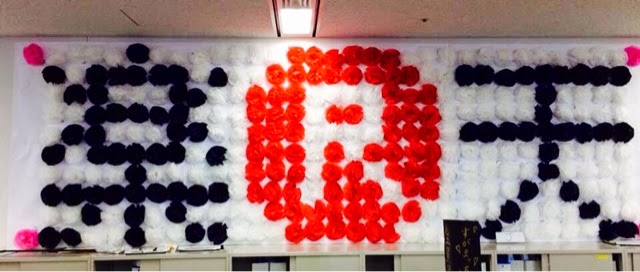Earlier this year Mt. Fuji was included in UNESCO's World Heritage List, making it Japan's 17th site on the list. As result the old volcano has experienced increased popularity, and not surprisingly the number of climbers who want to reach the top of Mt. Fuji is also on a rise. But although the view from Mt. Fuji is supposed to be very nice (when
I climbed Mt. Fuji last year the weather was so bad we could not see much besides the heavy clouds), it is perhaps even better to climb one of the nearby mountain to take a look at Mt. Fuji from afar.
Mt. Fuji seen from the camping area by lake Motosuko
Last weekend I went on a trip to the lake area around Mt. Fuji along with my BF Yuma and his parents for a two-day hiking/onsen/tourist-trip. Our first goal was to climb some of the small mountains surrounding Mt. Fuji in order to get a good view of the mountain. The area around Mt. Fuji is quite mountainous, and there are many routes to choose from. We had first planned to climb Ryugatake (龍ヶ岳), and we started out by the camping area by lake Motosuko (本栖湖) on the west side of the famous volcano. It is easy to find the track from there, and once you get to the sign that marks the entrance to the mountain trail you can follow the path all the way to the top.
Be aware of bears at Mt. Ryuugatake
Mt. Fuji seen from Mt. Ryuugaktake
At the summit of Mt. Ryuugatake
Apparently there are some legends behind the name Ryuugatake (Dragon Mountain) too. They all are quite similar, and build around the story that a dragon protected a village from Mt. Fuji's lava during an eruption. For more information about hiking Ryuugatake,
see this page (Japanese only).
集合写真
After our day in the mountain we spent the evening at a traditional Japanese hotel (Ryokan) called
Fuji Ginkei, situated by lake Kawaguchi (河口湖) with a nice view of Mt. Fuji. At the ryokan we were met with the utmost service, and after having gazed at Mt. Fuji from the hotel's outdoor hot bath (Rotenburo 露天風呂) it was time for Japanese style dinner. Traditional Japanese
washoku (和食) food is another expected Japanese contribution to the World Heritage List, and unless you either can't stand raw fish or are generally skeptical to unusual food you're guaranteed to get a lot of satisfaction out of a full course
washoku dinner. The staff really pay attention to the details, and every plate we got served looked like some sort of art.
The devil is in the detail.
Dinner time!
The view from our room. Unfortunately Mt. Fuji was all covered by clouds..
The next day it was quite cloudy so we could not get a proper view of Mt. Fuji from the hotel.. I've added this picture from
Fuji Ginkei's homepage, depicting their outdoor onsen and Mt. Fuji:
Mt Fuji seen from Fuji Ginkei's outdoor onsen
There are several interesting places to visit in the area as well. We visited the
Ichiku Kubota Art Museum, where in addition to exquisite kimonos you can enjoy the beautiful garden and various treasures collected by the artist himself from all around the world. Ichiku Kuboto became famous after having rediscovered the
Tsujigahana dying technique that had been lost since the 17th century. His museum featured a large number of kimonos he has made through his life, but unfortunately visitors are not allowed to take photographs inside the museum. I've only snapped a couple of pictures of the garden.
The entrance to Ichiku Kubota Art Museum
A red tree seen from the museum's gate.
In the back of the museum there is a cafe where you can enjoy the view of the beautiful garden
A door inside the garden leading to..
Another place that might be interesting to stop by for a short visit, is the small shrine called Tainai-jinja (胎内神社). From the outside it doesn't look like there is anything special about it, but when you enter you find that there is a hidden grotto in the back of the shrine's main building. The name Tainai actually means "interior of womb"...
Although Tainai jinja looks like an ordinary shrine, that is not totally the case..
A hidden pathway in the back of the shrine
A statue inside the "womb" grotto
Be prepared to have minimal space to move..
No place to be if you have claustrophobia..
I wouldn't recommend this place if you are afraid of being stuck underground.. But if you can cope with it, then this might be quite a unique experience to add to your list of adventures. It is not a very famous place, so there is not that information available. Place and description can however be found
here.
My last picture from the trip. Mt. Fuji and the pretty red leaves..
All in all Mt. Fuji makes a great travel destination even if you don't intend to climb it. There are many places to visit in the area, and I personally think seeing Mt. Fuji from afar in itself is a must for anyone visiting Japan.
I would also like to add that I had a fantastic weekend with Yuma and his parents, and I'm lucky that I have such wonderful people in my life. Hopefully we'll get to spend some quality time together again in the near future.
Related blog posts



























